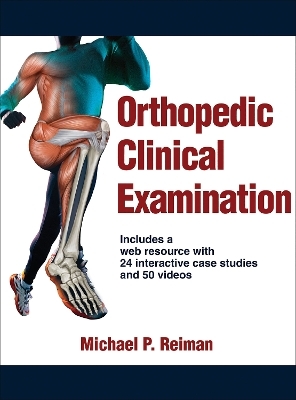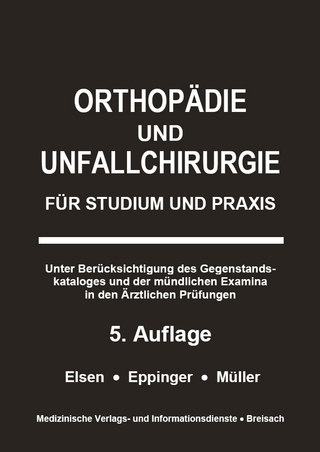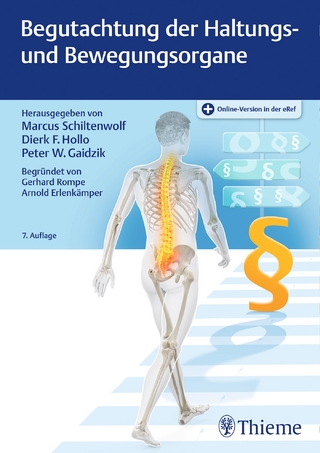
Orthopedic Clinical Examination
Human Kinetics (Verlag)
978-1-4504-5994-5 (ISBN)
Orthopedic Clinical Examination With Web Resource provides readers with fundamental knowledge for developing proficiency at performing systematic orthopedic evaluations. Michael P. Reiman, who is internationally respected for his teaching, clinical practice, and research focused on orthopedic assessment and treatment methods, presents an evidence-based guide on the examination process for various parts of the body.
The text takes a structured approach, moving from broad to focused, that guides clinicians in examining each client and condition. The text presents specific components of the examination in the same sequence, ensuring repetition and improved consistency in learning. Screenings are used early in the examination sequence not only to determine the appropriateness of performing an orthopedic examination but also to rule out other potential pain generators and thereby narrow the focus of the examination.
Orthopedic Clinical Examination emphasizes evidence-based practice and therefore focuses on tests that are clinically relevant, providing students and clinicians with the most appropriate testing options rather than listing tests with no regard for their clinical value. Both treatment-based and pathological-based diagnostic styles are covered in detail so that readers will gain a thorough understanding of both approaches and be able to implement them separately or in tandem. In addition to musculoskeletal testing, the text provides information on including subjective history, observation, diagnostic imaging, systems and neurological screening, and performance-based measures in each examination.
The text is organized into five parts and is structured such that readers will first acquire requisite knowledge about anatomy and the examination process before advancing to acquiring specific examination skills. Part I presents information about the musculoskeletal and nervous systems as well as tissue behavior and healing. Part II introduces the principles of the examination sequence. Parts III and IV present the region-specific examination sequence for evaluating clients, including specifics on analyzing the head, spine, and extremities. Each chapter in these two parts covers the anatomy of the region, various types of injuries that occur, specific tests and measures that can be used, and cross-references to specific case studies for further review. Part V highlights additional considerations that may be necessary for special populations during the examination process.
Orthopedic Clinical Examination includes learning tools that enhance comprehension and engagement:
• Full-color photographs and illustrations demonstrate anatomy, patient conditions, and clinician positioning to serve as a visual reference and ensure proper testing techniques.
• A library of 50 videos, found in the web resource, provides students with visual demonstrations of assessments and treatments.
• Color-coding graphics throughout chapters help readers quickly discern whether evidence supporting the reported finding is ideal, good, or less than good.
• Overviews of common orthopedic conditions for each body region are in the 12 applied chapters.
• Twenty-four case studies guide users in the proper questions to ask and steps to take in conducting examinations.
• Linkss to abstracts of articles provide additional clinical learning scenarios.
With Orthopedic Clinical Examination, current and future clinicians will gain the knowledge and confidence they need in performing examinations to provide optimal patient care.
Michael P. Reiman, PT, DPT, OCS, SCS, ATC, FAAOMPT, CSCS, is an assistant professor of physical therapy and the codirector of the orthopaedic manual therapy fellowship program at Duke University Medical Center. As a clinician, Reiman has more than 20 years of experience assessing, rehabilitating, and training athletes and clients. He has presented on orthopedic assessment and treatment methods at national and international conferences and actively participates in research regarding various testing methods for orthopedic examination and intervention and human performance. Reiman coauthored Functional Testing in Human Performance and has written 12 book chapters and more than 40 peer-reviewed articles. He currently serves on the editorial boards for multiple sport- and orthopedic-related journals. Reiman received his doctoral degree in physical therapy from MGH Institute of Health Professions and is currently pursuing his PhD. In addition to his certifications as an athletic trainer and strength and conditioning specialist, Reiman is a manual therapy fellow through the American Academy of Orthopedic and Manual Physical Therapists, a USA Weightlifting level 1 coach, and a USA Track and Field level 1 coach. He is also the chair of the Sports Section Hip Special Interest Group of the American Physical Therapy Association.
Part I. Review of Anatomy Systems
Chapter 1. Musculoskeletal System
Gilbert M. Willett, PT, PhD, OCS, CSCS; Michael P. Reiman, PT, DPT, OCS, SCS, ATC, FAAOMPT, CSCS
Bones
Joints
Skeletal Muscle and Connective Tissues
Conclusion
Chapter 2. Nervous System and Pain
Michael P. Reiman, PT, DPT, OCS, SCS, ATC, FAAOMPT, CSCS; Adriaan Louw, PT, PhD, CSMT
Structural Divisions of the Nervous System
Neuromuscular Control
Neurophysiology of Pain
Conclusion
Chapter 3. Tissue Injury and Healing
Mark F. Reinking, PT, PhD, SCS, ATC; Michael P. Reiman, PT, DPT, OCS, SCS, ATC, FAAOMPT, CSCS
Tissue Healing
Muscle Injury
Tendon Injury
Ligament Injury
Bone Injury
Articular Cartilage Injury
Peripheral Nerve Injury
Conclusion
Part II. Concepts and Principles of Examination
Chapter 4. Evidence-Based Practice and Client Examination
Michael P. Reiman, PT, DPT, OCS, SCS, ATC, FAAOMPT, CSCS
Evidence-Based Practice and Diagnostic Accuracy
Study Quality
Broad to Narrow or Funnel Examination Focus
Integration of Funnel Examination Approach
The Examination Continuum
Basic Principles of the Examination Process
Conclusion
Chapter 5. Client Interview and Observation
Jonathan Sylvain, PT, DPT, OCS, FAAOMPT; Michael P. Reiman, PT, DPT, OCS, SCS, ATC, FAAOMPT, CSCS
Effective Communication in the Client Interview and History
Common Barriers to Effective Communication
Qualities of an Effective Interview
Standard Client Interview
Client Interviews Relative to Musculoskeletal Pain
Outcome Measurements
Observation
Clinical Reasoning
Conclusion
Chapter 6. Triage and Differential Diagnosis
Michael P. Reiman, PT, DPT, OCS, SCS, ATC, FAAOMPT, CSCS
Triage Screening for Red and Yellow Flags
Diagnostic Imaging
Vital Signs
Differential Diagnosis and Medical Screening Examination
Treatment Based Classification
Conclusion
Chapter 7. Orthopedic Screening and Nervous System Examination
Michael P. Reiman, PT, DPT, OCS, SCS, ATC, FAAOMPT, CSCS; Adriaan Louw, PT, PhD, CSMT
Musculoskeletal Screening
Examination of the Physical Health of the Nervous System
Peripheral Nerve Examination
Conclusion
Chapter 8. Range of Motion Assessment
Michael P. Reiman, PT, DPT, OCS, SCS, ATC, FAAOMPT, CSCS
Range of Motion and Flexibility
Goniometry
Qualitative Assessment of Motion
Conclusion
Chapter 9. Muscle Performance and Neuromuscular Control
Michael P. Reiman, PT, DPT, OCS, SCS, ATC, FAAOMPT, CSCS
Components of Muscle Performance
Factors Affecting Muscle Performance
Clinical Measures of Muscle Performance
Conclusion
Chapter 10. Special Tests
Michael P. Reiman, PT, DPT, OCS, SCS, ATC, FAAOMPT, CSCS
Examination Procedure
Diagnostic Application of Special Tests
Conclusion
Chapter 11. Palpation
B. James Massey, PT, DPT, OCS, FAAOMPT
Palpation Procedure
Palpation Components of the Musculoskeletal Examination
Abdominal Palpation
Pulse Palpation
Bony Landmark Palpation
Joint Motion
Conclusion
Chapter 12. Physical Performance Measures
Robert J. Butler, PT, DPT, PhD
Overview of Testing Hierarchy
Single Body-Weight Physical Performance Measures
Single Body-Weight Loading
Single Body-Weight Loading and Momentum
Agility
Aerobic Capacity
Upper Extremity
General Core Stabilization
Conclusion
Chapter 13. Gait
Janice K. Loudon, PT, PhD, SCS, ATC
Walking Gait
Running Gait
Biomechanical Analysis of Walking and Running
Conclusion
Chapter 14. Posture
Michael P. Reiman, PT, DPT, OCS, SCS, ATC, FAAOMPT, CSCS
Body Type
Optimal Standing Posture
Other Posture Positions
Abnormal Postures
Dynamic Posture
Palpation Assessment of Thoracic Posture
Conclusion
Part III. Examination of the Head and Spine
Chapter 15. Face and Head
Michael P. Reiman, PT, DPT, OCS, SCS, ATC, FAAOMPT, CSCS
Clinically Applied Anatomy
Client Interview
Observation
Triage and Screening
Motion Tests
Muscle Performance Testing
Special Tests
Palpation
Physical Performance Measures
Common Orthopedic Conditions of the Face and Head
Conclusion
Chapter 16. Temporomandibular Joint
Michael P. Reiman, PT, DPT, OCS, SCS, ATC, FAAOMPT, CSCS
Clinically Applied Anatomy
Client Interview
Observation
Triage and Screening
Motion Tests
Muscle Performance Testing
Special Tests
Palpation
Physical Performance Measures
Common Orthopedic Conditions of the Temporomandibular Joint
Conclusion
Chapter 17. Cervical Spine
Michael P. Reiman, PT, DPT, OCS, SCS, ATC, FAAOMPT, CSCS
Clinically Applied Anatomy
Client Interview
Observation
Triage and Screening
Motion Tests
Muscle Performance Testing
Special Tests
Palpation
Physical Performance Measures
Common Orthopedic Conditions of the Cervical Spine
Conclusion
Chapter 18. Thoracic Spine
Michael P. Reiman, PT, DPT, OCS, SCS, ATC, FAAOMPT, CSCS
Clinically Applied Anatomy
Client Interview
Observation
Triage and Screening
Motion Tests
Muscle Performance Testing
Special Tests
Palpation
Physical Performance Measures
Common Orthopedic Conditions of the Thoracic Spine
Conclusion
Chapter 19. Lumbar Spine
Michael P. Reiman, PT, DPT, OCS, SCS, ATC, FAAOMPT, CSCS
Clinically Applied Anatomy
Client Interview
Observation
Triage and Screening
Motion Tests
Muscle Performance Testing
Special Tests
Palpation
Physical Performance Measures
Common Orthopedic Conditions of the Lumbar Spine
Conclusion
Chapter 20. Sacroiliac Joint and Pelvic Girdle
Michael P. Reiman, PT, DPT, OCS, SCS, ATC, FAAOMPT, CSCS
Clinically Applied Anatomy
Client Interview
Observation
Triage and Screening
Motion Tests
Muscle Performance Testing
Special Tests
Palpation
Physical Performance Measures
Common Orthopedic Conditions of the Sacroiliac Joint and Pelvic Girdle
Conclusion
Part IV. Examination of the Extremities
Chapter 21. Shoulder
Michael P. Reiman, PT, DPT, OCS, SCS, ATC, FAAOMPT, CSCS; Christopher Fiander, PT, DPT, OCS, CSCS
Clinically Applied Anatomy
Client Interview
Observation
Triage and Screening
Motion Tests
Muscle Performance Testing
Special Tests
Palpation
Physical Performance Measures
Common Orthopedic Conditions of the Shoulder Joint
Conclusion
Chapter 22. Elbow and Forearm
Dawn Driesner Kennedy, PT, DPT, OCS, COMT, FAAOMPT; Michael P. Reiman, PT, DPT, OCS, SCS, ATC, FAAOMPT, CSCS
Clinically Applied Anatomy
Client Interview
Observation
Triage and Screening
Motion Tests
Muscle Performance Testing
Special Tests
Palpation
Physical Performance Measures
Common Orthopedic Conditions of the Elbow Joint
Conclusion
Chapter 23. Wrist and Hand
Jonathan Sylvain, PT, DPT, OCS, FAAOMPT; Michael P. Reiman, PT, DPT, OCS, SCS, ATC, FAAOMPT, CSCS; Gary P. Austin, PT, PhD, OCS, FAFS, FAAOMPT
Clinically Applied Anatomy
Client Interview
Observation
Triage and Screening
Motion Tests
Muscle Performance Testing
Special Tests
Palpation
Physical Performance Measures
Common Orthopedic Conditions of the Wrist and Hand
Conclusion
Chapter 24. Hip
Michael P. Reiman, PT, DPT, OCS, SCS, ATC, FAAOMPT, CSCS
Clinically Applied Anatomy
Client Interview
Observation
Triage and Screening
Motion Tests
Muscle Performance Testing
Special Tests
Palpation
Physical Performance Measures
Common Orthopedic Conditions of the Hip Joint
Conclusion
Chapter 25. Knee
David Logerstedt, PT, PhD, MPT, SCS; Michael P. Reiman, PT, DPT, OCS, SCS, ATC, FAAOMPT, CSCS
Clinically Applied Anatomy
Client Interview
Observation
Triage and Screening
Motion Tests
Muscle Performance Testing
Special Tests
Palpation
Physical Performance Measures
Common Orthopedic Conditions of the Knee
Conclusion
Chapter 26. Lower Leg, Ankle, and Foot
Shefali Christopher, PT, DPT, SCS, LAT, ATC; Michael P. Reiman, PT, DPT, OCS, SCS, ATC, FAAOMPT, CSCS
Clinically Applied Anatomy
Client Interview
Observation
Triage and Screening
Motion Tests
Muscle Performance Testing
Special Tests
Palpation
Physical Performance Measures
Common Orthopedic Conditions of the Lower Leg, Ankle, and Foot
Conclusion
Part V. Examination of Special Populations
Chapter 27. Emergency Sport Examination
John DeWitt, PT, DPT, SCS, ATC; Mitch Salsbery, PT, DPT, SCS, CSCS
Sports-Related Concussion
Cervical Spine Injuries
Cardiac Disorders
Compartment Syndrome
Asthma
Pneumothorax
Heat-Related Illness
Fractures
Endocrine emergencies
Conclusion
Chapter 28. Geriatric Examination
Michael Schmidt, PT, DPT, OCS, FAAOMPT; Charles Sheets, PT, OCS, SCS, Dip MDT; Tasala Rufai, PT, DPT, GCS
Influence of Age on Diagnosis
Change in Tissue Properties as a Result of Aging
Influence of Age on Pain
Physical Requirements for Activities of Daily Living
Osteoporosis
Examination of Balance
Conclusion
Chapter 29. Pediatric Examination
Dora J. Gosselin, PT, DPT, PCS, C/NDT
Child’s Musculoskeletal System
Multisystem Pathologies
Pathologies of the Spine
Upper Extremity Pathology
Lower Extremity Pathology
Conclusion
| Erscheinungsdatum | 02.03.2016 |
|---|---|
| Verlagsort | Champaign, IL |
| Sprache | englisch |
| Maße | 216 x 279 mm |
| Gewicht | 3402 g |
| Themenwelt | Medizinische Fachgebiete ► Chirurgie ► Unfallchirurgie / Orthopädie |
| Medizinische Fachgebiete ► Innere Medizin ► Rheumatologie | |
| Medizin / Pharmazie ► Medizinische Fachgebiete ► Orthopädie | |
| Medizin / Pharmazie ► Physiotherapie / Ergotherapie | |
| ISBN-10 | 1-4504-5994-3 / 1450459943 |
| ISBN-13 | 978-1-4504-5994-5 / 9781450459945 |
| Zustand | Neuware |
| Haben Sie eine Frage zum Produkt? |
aus dem Bereich


